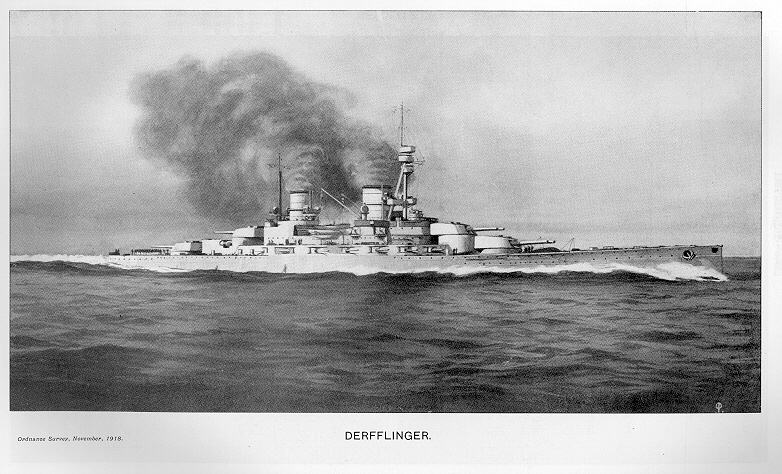
 |
Derflinger Class Battle Cruisers |
|---|

| Main Armament: | Eight 30.5 cm quick firing guns of 50 calibres length arranged in four double turrets. Two superfiring turrets on amidships line fore and aft. |
|---|---|
| Secondary and Tertiary Armaments: |
Twelve aboard Derfflinger, and fourteen aboard Lützow and Hindenburg, 15 cm quick firing guns of 45 calibres length in casemates. Derfflinger built with eight 88 mm quick firing guns single mount shielded, which were removed in 1916. Eight, later reduced to four, single mount 88 mm anti-aircraft guns. Lützow built with only eight single mount 88 mm shielded quick firing guns. Hindenburg built with eight 88 mm quick firing guns, later reduced to four single mount 88 mm anti-aircraft guns. All ships in the class were built with four torpedo tubes, all underwater, arranged one in bow, one in stern on port side, and one on each beam. Torpedo tubes were 50 cm aboard Derfflinger, and 60 cm aboard Lützow and Hindenburg. |
| Armor: | Armoured traverse bulkheads: stern/100mm, vital parts/250mm, bow/250mm... Side armour: stern/100mm, vital parts/300mm tapered towards waterline to 150mm, bow/tapering towards bow 120mm-100mm-30mm...Citadel armour: 230mm-270mm... Horizontal armour: superstructure decks above casemates/50mm, upper deck/20mm- 25mm, armoured deck/after portion 80mm, other parts 30mm-40mm including the inclines...Heavy armament: barbettes/260mm, turrets-front/270mm- sides/220mm-tops/110mm-80mm (Hindenburg had 150mm side turret armour)... Conning tower: forward part/350mm, after part/200mm. |
| Machinery: | Fourteen twin coal fired, and four double ended oil fired naval boilers
feeding two steam turbines driving four propeller shafts. Machinery installation
developed 63,000 shaft horsepower at 26.5 knots. Hindenburg developed 72,000
shaft horsepower at 27.0 knots. Two rudders arranged in line amidships. Wartime
trial run results were: S.M.S. Derfflinger: 76,600 s.h.p. at 25.8 knots. S.M.S. Lützow: 80,988 s.h.p. at 26.4 knots. S.M.S. Hindenburg: 95,777 s.h.p. at 26.6 knots. |
